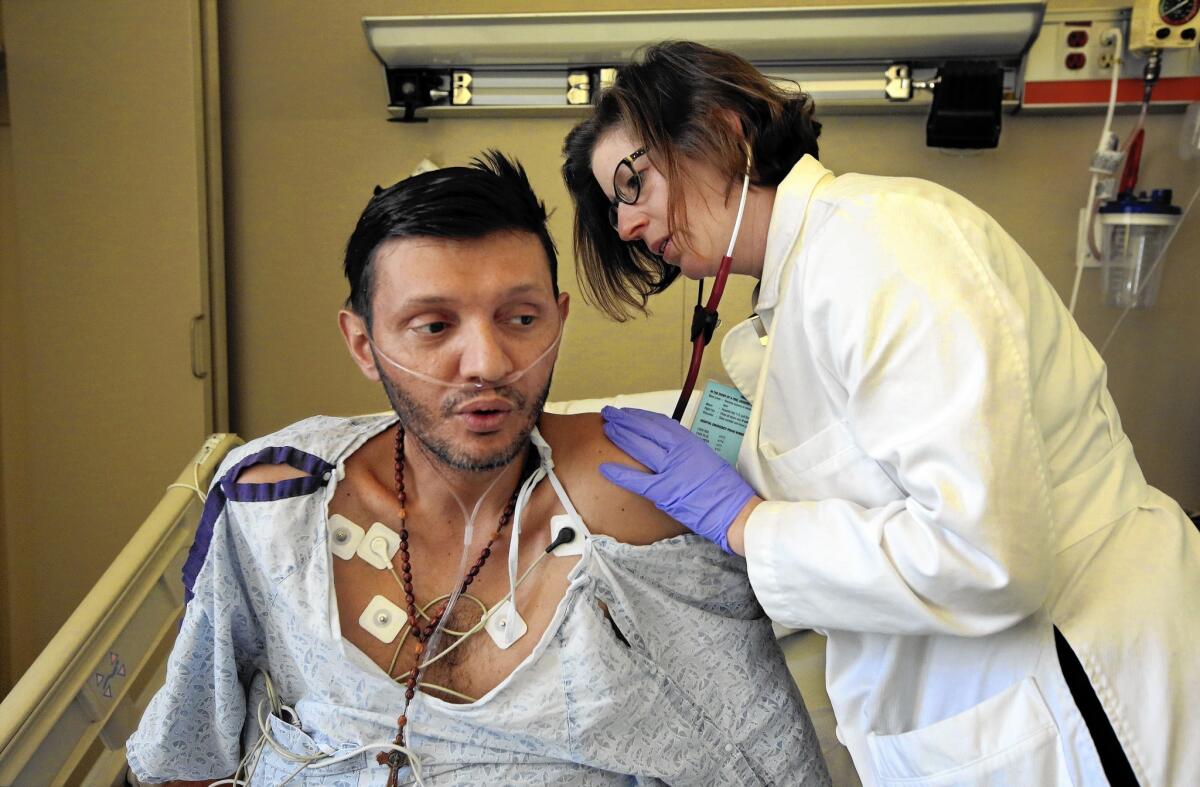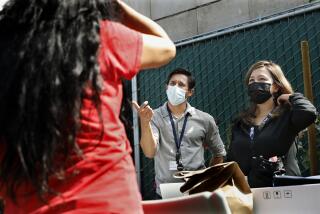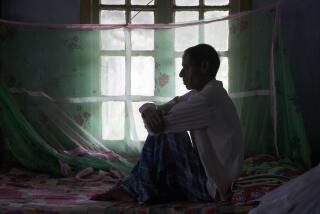Drug-resistant tuberculosis a tiny — but potent — foe in L.A. County

- Share via
It was unlike anything Dr. Caitlin Reed had encountered in years of treating Los Angeles County’s toughest tuberculosis cases.
Gary A., a Hollywood resident with a complicated medical history, had arrived at a local hospital with a high fever and what seemed to be pneumonia. As he grew sicker and sicker, doctors figured out that he had tuberculosis — but none of the standard antibiotic treatments made him better.
Reed, who runs a dedicated TB unit at Olive View-UCLA Medical Center in Sylmar, had Gary transferred into her care and sent samples of bacteria collected from his lungs to the Centers for Disease Control and Prevention and other labs across the country, to see what drugs might knock it down.
The stakes were high, not just for her patient but also for Los Angeles and California, where hundreds of people are diagnosed with tuberculosis each year.
Reed was dumbfounded by what the tests showed.
“I was standing there, looking at the fax from the CDC and thinking: ‘What are we going to do?’” she recently recalled.
Her patient’s tuberculosis looked as if it might be untreatable, impervious to all of the preferred drugs used to combat the disease and most of the backup options as well.
Reed believes Gary, who is 39, has the most extensively drug-resistant case of tuberculosis ever treated in the United States. Only a handful of patients in Los Angeles County have drug-resistant TB. Their treatment is grueling and expensive — and necessary to prevent further spread of the disease, which spreads through the air, public health officials said.
“It’s a serious concern,” said Dr. Jennifer Flood, chief of the TB Control branch at the California Department of Public Health. “It’s crucial to make sure patients have access to therapy.”
Tuberculosis has plagued humanity for centuries.
A hundred years ago, there were dozens of TB sanitariums scattered throughout California. Today, thanks to antibiotics and public-health vigilance, facilities such as Reed’s are a rarity, Flood said.
Internationally, however, tuberculosis remains a major threat.
The World Health Organization estimates that as many as a third of people worldwide have been infected with Mycobacterium tuberculosis. In 2013, the agency said, 9 million people saw their infections escalate into full-blown, contagious TB, and 1.5 million people died from the illness.
In 2013, the Los Angeles County Department of Public Health reported 662 new tuberculosis cases, 80% of which emerged in foreign-born patients who probably contracted it before coming to the U.S. The illness can lurk in the body for decades before flaring up.
Five of the county’s 2013 cases were so-called multiple-drug-resistant tuberculosis, impervious to the two leading antibiotics used to fight the disease. One case, Gary’s, was considered extensively drug-resistant, meaning the leading drugs as well as many alternatives proved useless.
Gary probably contracted drug-resistant TB abroad. His illness flared up in 2013 after he started taking immune-system-suppressing drugs to treat a separate medical condition, his sister Stephanie said.
To combat a case such as his, Reed said, the World Health Organization recommends administering a combination of five, or better yet six, drugs. But test results suggested that Gary’s infection was resistant to all but two. Reed tried a total of 10 drugs, including a newly approved one called bedaquiline, not fully knowing which might work.
She was able to get the infection to the point where it was no longer contagious and Gary could undergo surgery to have a lung removed. The procedure left him oxygen-dependent but alive — a success, given the dire circumstances, Reed said.
Gary — whose care, the doctor estimated, ultimately could cost more than $1 million — needs to remain on multiple anti-TB drugs for two years to complete his treatment. But the medications he was taking were causing irreversible damage to his nerves, making it hard for him to hear and to walk.
Stuck between “a bad choice and a worse choice,” Reed and Gary’s other doctors discontinued one of the more effective medicines in late 2014. But Reed hoped a new treatment option would arise: She had been pushing since March to get Gary access to a new TB drug called delamanid, which has not yet won approval for use in the U.S.
Otsuka Pharmaceutical, the Japanese company that makes delamanid, has denied Reed’s application to a compassionate-use program it has set up to speed the drug to patients in dire need.
Marc Destito, a spokesman for the company, said that delamanid hadn’t been tested yet in combination with bedaquiline, which Gary still takes. Both drugs have been shown in studies to affect heart rhythms.
“We really believe these drugs have to be studied together first,” Destito said.
Reed argues that Gary is a perfect candidate for the drug and called the company’s position “profoundly uncompassionate.”
“It pains me to know there’s another thing that could have avoided some of these consequences. It keeps me up at night,” she said. “Even if he survives, he’ll be permanently disabled. You swear an oath to do no harm. I’ve done some harm.”
Reed worries, as well, that sufficient medications won’t be available to help the next patient with multiple drug-resistant or extensively drug-resistant tuberculosis — and, by extension, the people around that patient.
Large numbers of L.A. residents may have been exposed to tuberculosis before arriving in the region. As they age, some will develop the full-blown disease. At some increased risk are the large numbers of Angelenos with diabetes, which can suppress the immune system and allow active TB to take hold.
Reed has noticed that many of the patients she has treated from skid row — where an outbreak of drug-susceptible TB has been ongoing since 2007 — are diabetic.
So far, to Reed’s knowledge, no cases of drug-resistant TB have been reported in the homeless outbreak. The possibility of one upsets her.
“I don’t even want to think about it,” she said, noting that it can be hard to manage patients on skid row and track contacts who might have been exposed to the disease. “It would be extremely challenging, extremely expensive and really scary and dangerous.”
Twitter: @LATerynbrown







